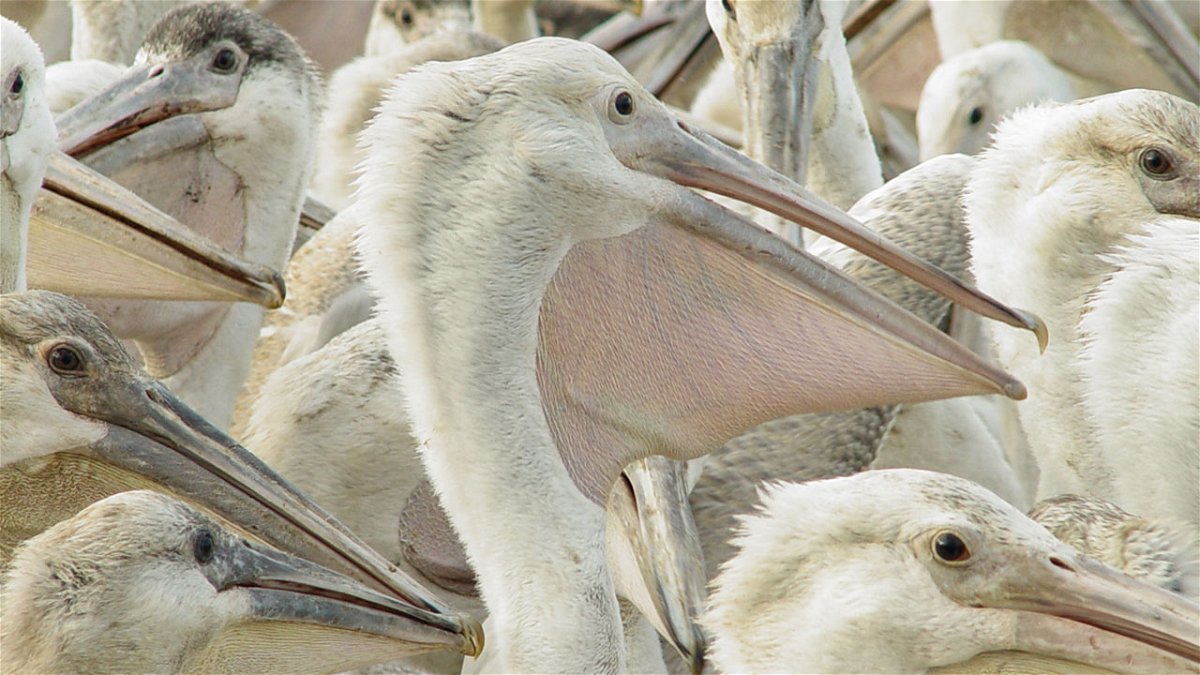F&G biologists work to protect a popular Yellowstone cutthroat fishery from pelican predation

BLACKFOOT RESERVOIR, Idaho (KIF) - Blackfoot Reservoir, located about 40 miles east of Pocatello, is home to two divergent, yet symbiotic, conservation stories that have been playing out in southeast Idaho for nearly 30 years, leaving Fish and Game biologists to find new innovative ways towards one common solution.
On one side of the coin is the Yellowstone cutthroat trout, a native species in the upper Snake River drainage that have declined in significant portions of their distribution. Their limited numbers have led to decades’ worth of research and management efforts by Fish and Game fisheries and wildlife biologists.
On the other side is another once-threatened species, the American white pelican, competing directly with Yellowstone cutthroat trout recovery efforts.

For nearly three decades, Fish and Game staff have been deploying a number of management strategies to find a balance between cutthroat trout and white pelicans. And, in 2022, that work is continuing.
The sky’s the limit
Across the U.S., pelicans were on the decline until around the 1960s. Since the ’80s, pelicans have seen a rise in numbers thanks to reduced pesticide use, increased federal and state protection and adapting to new environments.
Since the 1990s, pelicans have been breeding consistently at three nesting colonies across Idaho. The abundance of breeding adults increased significantly through the early 2010s and peaked in 2012. Blackfoot Reservoir’s Gull Island, for example, has been a popular pelican destination since as early as 1910. After a partnership with USDA Wildlife Services to rid the island of badgers in 1991 and 1992, pelicans took advantage of the predator-free real estate and began nesting on Gull Island in 1993.
Fish and Game biologists in the southeast region have been focusing their efforts on this conundrum since that year, when there were around just 200 breeding adult pelicans. In 2007, that number had soared to its peak of 3,400, before declining to an average of about 1,100 over the past 5 years.

Since 2010 the statewide breeding population has fluctuated annually. Since 2017, breeding adults have averaged around 4,600. In Idaho, pelicans predominantly forage on abundant populations of nongame fish resulting in non-consequential or acceptable impacts to other resource values and anglers.
However, pelican predation in some areas has a measurable impact on sport fishing and native trout conservation programs, most notably native Yellowstone cutthroat trout, creating conflict between pelican and fisheries management objectives.
Big birds, bigger problems
“At Blackfoot Reservoir, we’d like to consistently manage pelicans at our plan objective of 700 breeding adult birds,” said Regional Fisheries Manager Carson Watkins. “In recent history we’ve been about double that.”
Seeing the balance of pelicans and Yellowstone cutthroat trout beginning to teeter heavily towards the big white birds, Idaho Fish and Game unrolled its first pelican management plan back in 2009. Since pelicans are a federally protected species under the Migratory Bird Treaty Act, Fish and Game has been working in coordination with the U.S. Fish and Wildlife Service to monitor pelican populations in the Blackfoot River system and to manage predation impacts on the cutthroat trout fishery.
“Managing pelican predation has been a slow, uphill battle,” Regional Wildlife Manager Zach Lockyer said. “They are very intelligent birds — efficient fish-eaters, with a strong fidelity to their preferred nesting areas. Blackfoot is a big, complex system, which complicates managers’ ability to control where pelicans occur in space and time.”
The current American White Pelican Conservation Plan is a tightrope walk — establishing a management framework which keeps pelican populations healthy and viable but also reducing the impact of the colonies on native trout and recreational fisheries. How do you reduce the number of one federally protected species of concern on a body of water while simultaneously recovering the population of native fish species? Fish and Game staff argue there may be a solution.

The Pelican Effect
To survey the number of Yellowstone cutthroat trout in a fishery, one might assume the sole method for gathering this data is by netting the reservoir. Thanks to pelicans (relatively speaking), there is another way.
Fisheries biologists look not just to the water but to the land — specifically, a pelican’s nest — to help assess Yellowstone cutthroat trout populations in the fishery.
“In places where the pelicans are nesting, we can comb the area and scan for PIT tags regurgitated by the pelicans,” said Watkins. “This helps us understand the basic relationship between pelican abundance and fish predation.”
Fisheries staff have estimated that as much as 50 percent of PIT-tagged fish in Blackfoot Reservoir can be consumed by pelicans, which eat 4-5 pounds of fish a day.
“The observed predation has been pretty alarming,” Watkins said. “Monitoring the effect of pelicans is just half the battle at Blackfoot Reservoir. We’re also working on recovering native cutthroat trout toward an objective of 10,000 spawning fish, which takes an understanding of fish survival and population growth rates. Collectively, all these pieces support or inform elements of the state’s pelican management plan.”

Keeping the numbers in check
To bring pelicans within objective (700 breeding adults) as described in the Pelican Management Plan, Fish and Game staff have had to be creative and adapt to this long-lived intelligent bird.
In the past, Fish and Game staff have deployed many tactics in an effort to reduce pelican predation on Blackfoot Reservoir and the Blackfoot River, relying mostly on hazing the birds and excluding nesting in some places. The overall goals are to reduce the number of breeding birds at-large and to reduce the extent of foraging on the in-river cutthroat trout population. Pelicans, Lockyer argues, are intelligent and adaptable creatures, that often outwit efforts to manage the conflict.
“Every year can be a little different, as pelicans are extremely loyal to these bodies of water and persistent in their efforts to reproduce,” Lockyer said. As a result, Fish and Game has to constantly adapt and be creative to meet its goals.
In 2020 and 2021, however, Fish and Game began seeing a change in the pelicans’ daily routine, a change that may be a win-win after all for both pelicans and cutthroat trout.

On to greener pastures (well…mud flats)
About 17 miles away as the pelican flies lies Chesterfield Reservoir. In 2020, Fish and Game biologists started observing pelicans building nests on Chesterfield’s sole island near the western edge of the reservoir.
“There is very limited nesting habitat at Chesterfield,” Watkins said. “But, at least in 2020 and 2021, the pelicans found it suitable, as they established their nests at Chesterfield and ‘commuted’ to the Blackfoot River and other nearby bodies of water to feed.”
Fish and Game managers believe the Chesterfield birds to be part of the same colony from Blackfoot Reservoir, leaving biologists to wonder if the move to Chesterfield is a good fit after all.
With the majority of the Blackfoot colony nesting at Chesterfield, Fish and Game staff believe it will have a lower impact on the fish population since the birds may spend less time in the Blackfoot system. Although the pelican colony continues to feed at Blackfoot Reservoir, their overall imprint on the fishery is declining.
“Because of reduced hazing disturbance at Chesterfield, fledgling success has actually increased,” Lockyer mentioned. “There are still birds inhabiting Blackfoot, but we’re not allowing them to nest there. At Chesterfield, the colony can largely be left alone and thus a reduced disturbance to those birds. So, monitoring and management of pelicans at Chesterfield is simpler and potentially better for pelicans and cutthroat trout at Blackfoot.”

However, this dynamic system is continually changing, Lockyer added. Recent drought conditions have resulted in lower water levels in many Idaho reservoirs, including Chesterfield. In 2022, the nesting island at Chesterfield was not an “island” but was instead connected to the mainland due to low water.
The result? No more pelicans nesting at Chesterfield.
What seemed to be an excellent management shift the past two years for pelicans and cutthroat trout is proving to be an entirely new challenge for wildlife and fisheries managers.
“Cutthroat trout recovery and adherence to Idaho’s Pelican Management Plan will remain forefront as both fisheries and wildlife managers continue to work on this interesting and challenging situation,” Lockyer said. “Will Chesterfield serve as a long term solution into the future? Only time will tell.”
It has and will continue to be a delicate balance between both pelicans and Yellowstone cutthroat trout. Blackfoot Reservoir may still provide quality feeding grounds for the large white birds, but through continuous effort, Fish and Game is working to eliminate nesting there while ensuring a prized native cutthroat trout continues to rebound in its home waters.






